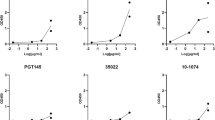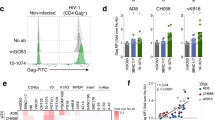Abstract
Rhesus monkeys were infected with mutant forms of simian immunodeficiency virus lacking dual combinations of the 4th, 5th and 6th sites for N-linked glycosylation in the external envelope glycoprotein of the virus. When compared with sera from monkeys infected with the parental virus, sera from monkeys infected with the mutant viruses exhibited markedly increased antibody binding to specific peptides from this region and markedly increased neutralizing activity. These results demonstrate a role for N-linked glycosylation in limiting the neutralizing antibody response to SIV and in shielding the virus from immune recognition.
This is a preview of subscription content, access via your institution
Access options
Subscribe to this journal
Receive 12 print issues and online access
$209.00 per year
only $17.42 per issue
Buy this article
- Purchase on Springer Link
- Instant access to full article PDF
Prices may be subject to local taxes which are calculated during checkout
Similar content being viewed by others

References
Wei, et al. Viral dynamics in human immunodeficiency virus type 1 infection. Nature 373, 117–122 (1995).
Ho, D.D. et al. Rapid turnover of plasma virions and CD4 lymphocytes in HIV-1 infection. Nature 373, 123–126 (1995).
Koup, R.A. et al. Temporal association of cellular immune responses with the initial control of viremia in primary human immunodeficiency virus type 1 syndrome. J. Virol. 68, 4650–4655 (1994).
Coffin, J.M. HIV population dynamics in vivo: implications for genetic variation, pathogenesis, and therapy. Science 267, 483–489 (1995).
Pantaleo, G., Vaccarezza, M., Graziosi, C., Cohen, O.J. & Fauci, A. Antiviral immunity in HIV-1 infected long-term non-progressors (LTNPs). Semin. Virol. 7, 131–138 (1996).
Wolinski, S.M. et al. Adaptive evolution of human immunodeficiency virus-type 1 during the natural course of infection. Science 272, 537–542 (1996).
Burns, D.P.W., Collignon, C. & Desrosiers, R.C. Simian immunodeficiency virus mutants resistant to serum neutralization arise during persistent infection of rhesus monkeys. J. Virol. 67, 4104–4113 (1993).
Chackerian, B., Rudensey, L.M. & Overbaugh, J. Specific N-linked and O-linked glyco-sylation modifications in the envelope VI domain of simian immunodeficiency virus that evolve in the host alter recognition by neutralizing antibodies. J. Virol. 71, 7719–7727 (1997).
Borrow, P. et al. Antiviral pressure exerted by HIV-1 -specific cytotoxic T lymphocytes (CTLs) during primary infection demonstrated by rapid selection of CTL escape virus. Nature Med. 3, 205–211 (1997).
Goulder, P.J.R. et al. Late escape from an immunodominant cytotoxic T-lymphocyte response associated with progression to AIDS. Nature Med. 3, 212 (1997).
Leonard, C.K. et al. Assignment of intrachain disulfide bonds and characterization of potential glycosylation sites of the type 1 recombinant human immunodeficiency virus envelope glycoprotein (gpi 20) expressed in Chinese hamster ovary cells. J. Biol. Chem. 265, 10373–10382 (1990).
Back, N.K.T. et al. An N-glycan within the human immunodeficiency virus type 1 gpl 20 V3 loop affects virus neutralization. Virology 199, 431–438 (1994).
Schonning, D., Jansson, B., Olofsson, S. & Hansen, J.-E.S. Rapid selection for an N-linked oligosaccharide by monoclonal antibodies directed against the V3 loop of human immunodeficiency virus type 1. J. Gen. Virol. 77, 753–758 (1996).
Bolmstedt, A. et al. Carbohydrate determinant NeuAc-Gal(1–4) of N-linked glycans modulates the antigenic activity of human immunodeficiency virus type 1 glycoprotein gp120. J. Gen. Virol. 73, 3099–3105 (1992).
Schonning, K., Jansson, B., Olofsson, S., Nielsen, J.O. & Hansen, J.-E.S. Resistance to V3-directed neutralization caused by an N-linked oligosaccharide depends on the quaternary structure of the HIV-1 envelope oligomer. Virology 218, 134–140 (1996).
Bolmstedt, A. et al. Influence of N-linked glycans in V4–V5 region of human immunodeficiency virus type 1 glycoprotein gpl 60 on induction of a virus-neutralizing humoral response. J. Acquired Immune Defic. Syndr. Hum. Retrovirol. 12, 213–220 (1996).
Benjouad, A., Mabrouk, K., Gluckman, J.C. & Fenouillet, E. Effect of sialic acid removal on the antibody response to the third variable domain of human immunodeficiency virus type-1 envelope glycoprotein. FEBS Lett. 341, 244–250 (1994).
Fouts, T.R., Binley, J.M., Trkola, A., Robinson, J.E. & Moore, J.P. Neutralization of the human immunodeficiency virus type 1 primary isolate JR-FL by human monoclonal antibodies correlates with antibody binding to the oligomeric form of the envelope glycoprotein complex. J. Virol. 71, 2779–2785 (1997).
Burton, D.R. A vaccine for HIV type 1: The antibody perspective. Proc.Natl.Acad. Sci. USA 94, 10018–10023 (1997).
Reitter, J.N. & Desrosiers, R.C. Attachment sites for N-linked carbohydrates in variable region 1 of envelope are dispensable for replication of simian immunodeficiency virus. J. Virol. (in the press).
Desrosiers, R.C. et al. Identification of highly attenuated mutants of simian immunodeficiency virus. J. Virol. 72, 1431–1437(1998).
Burns, D.P.W. & Desrosiers, R.C. Selection of genetic variants of simian immunodeficiency virus in persistently infected rhesus monkeys. J. Virol. 65, 1843–1854 (1991).
Means, R.E. & Desrosiers, R.C. Neutralization sensitivity of cell culture passaged simian immunodeficiency virus. J. Virol. 71, 7895–7902 (1997).
Wiley, D.C., Wilson, I.A. & Skehel, J.J. in Biological Macromolecules and Assemblies. Vol. 1 (ed. McPherson, A.) 299–336 (John Wiley & Sons,1984).
Doe, B., Steimer, K.S. & Walker, C.M. Induction of HIV-1 envelope (gpl 20)-specific cytotoxic T lymphocyte responses in mice by recombinant CHO cell-derived gpl 20 is enhanced by enzymatic removal of N-linked glycans. Eur. J. Immunol. 24, 2369–2376 (1994).
Koff, W.C. The next steps toward a global AIDS vaccine. Science 266, 1335–1337 (1994).
Wyand, M.S., Manson, K.H., Garcia-Moll, M., Montefiori, D. & Desrosiers, R.C. Vaccine protection by a triple deletion mutant of simian immunodeficiency virus. J. Virol. 70, 3724–3733 (1996).
Daniel, M.D. et al. Long-term persistent infection of macaque monkeys with the simian immunodeficiency virus. J. Gen. Virol. 68, 3183–3189 (1987).
Author information
Authors and Affiliations
Rights and permissions
About this article
Cite this article
Reitter, J., Means, R. & Desrosiers, R. A role for carbohydrates in immune evasion in AIDS. Nat Med 4, 679–684 (1998). https://doi.org/10.1038/nm0698-679
Received:
Accepted:
Issue Date:
DOI: https://doi.org/10.1038/nm0698-679
This article is cited by
-
Isolation and molecular characterization of GP5 glycoprotein gene of Betaarterivirus suid 2 from Mizoram, India
VirusDisease (2021)
-
Longitudinal analysis of subtype C envelope tropism for memory CD4+ T cell subsets over the first 3 years of untreated HIV-1 infection
Retrovirology (2020)
-
Genotyping bovine leukemia virus in dairy cattle of Heilongjiang, northeastern China
BMC Veterinary Research (2019)
-
Rationally designed carbohydrate-occluded epitopes elicit HIV-1 Env-specific antibodies
Nature Communications (2019)
-
Global site-specific N-glycosylation analysis of HIV envelope glycoprotein
Nature Communications (2017)


